Final Fantasy X Ps3 Easy Blitzball Win
April 15, 2012
The world lies on the brink of destruction. Only a select few may be able to save it.
Tagline
This article is about the game. For the information about the game's subseries, see Final Fantasy X series
Final Fantasy X is the tenth main installment in the Final Fantasy series, developed and published by Squaresoft. It was released in July 2001 for the PlayStation 2 and has since been re-released as part of the Final Fantasy X/X-2 HD Remaster for PlayStation 3 and PlayStation Vita in 2013, for PlayStation 4 in 2015, for Microsoft Windows in 2016, and for Nintendo Switch and Xbox One in 2019. It was directed by Yoshinori Kitase, with Tetsuya Nomura providing the character design and Nobuo Uematsu and Masashi Hamauzu composing the score. It was the first title in the series released on sixth-generation consoles, the first to feature fully three-dimensional areas rather than including pre-rendered backdrops, and the first to include voice acting.
The game is set in the world of Spira and follows the story of Tidus and Yuna. Tidus is a star athlete blitzball player, who is taken to Spira by Auron after a monster called Sin destroys his home city of Zanarkand. Tidus then joins the summoner, Yuna on her pilgrimage with her guardians to defeat Sin and bring about the Calm.
The gameplay makes use of the Conditional Turn-Based Battle system rather than the typical Active Time Battle, in which characters' stats and other factors determine when they get a turn. Parties consist of three members, though it is possible to swap out a character for another party member at any time. Characters can unlock abilities using the Sphere Grid, which sets character down a specific path with stats and abilities, but eventually opens up, allowing characters to unlock all abilities (aside from Yuna's summon). Each character also has a unique set of abilities known as their Overdrive. Locations are mostly linear and are not connected by a world map, though players can revisit locations at any point once the airship is obtained.
Final Fantasy X received widespread critical acclaim, with a score of 92/100 on Metacritic, praising its visual presentation, storyline, and gameplay improvements.[8] It was the first title to receive a direct sequel in Final Fantasy X-2. In 2004, Square Enix announced the game sold around 6.6 million copies,[9] and in 2013, the company announced that the Final Fantasy X series had sold over 14 million copies.[10]
Gameplay [ ]
The Sphere Grid [ ]
Main article: Sphere Grid
Character growth is undertaken by use of the Sphere Grid. By gaining AP from battles and collecting different types of spheres, characters move through the grid, raise their stats, and learn new abilities.
The sphere grid allows the player to evolve and take on "mixed" abilities, meaning they can learn a wide array of Black Magic, White Magic, Defense, and Attack skills. The International Version (see below) introduced a new grid which has 36 fewer nodes and undefined paths for each character, meaning they can take any role they choose.
Battle system [ ]
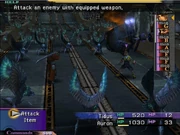
The CTB from Final Fantasy X.
The battle system used is the Conditional Turn-Based Battle (CTB) system, also known as the Count Time Battle system in Japan.
CTB is a turn-based system, which does not operate in rounds; characters with higher Agility take more turns, thus making speed more important than in other turn-based battle systems. Spells and abilities (such as Haste) can modify the turn order (called the Act List), as some abilities require a longer cooldown time. Weaker abilities tend to require less cooldown, thus introducing a trade-off between speed and power.
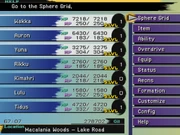
Menu screen.
When a character's turn begins, all action stops while the player decides upon an action. This shifts the focus from reflexes and quick decision-making to strategy and careful planning. The player can change characters on the go.
Minigames [ ]
- Blitzball - The feature minigame is blitzball, a cross between football (soccer), and water polo, played underwater in a giant sphere pool at Luca. Recruiting players is a big part of blitzball; getting new and better players, and knowing who to cut and when, can be the thing that makes or breaks the team. Blitzball is known throughout the races of Spira as a distraction from the death and destruction that Sin brings.
- Chocobo Racing - A chocobo training and racing game can be played in the Calm Lands. The player participates in several challenges to train a chocobo and then uses those skills to race another chocobo at Remiem Temple.
- Monster Arena - When fiends from all over Spira are captured using special weapons, they appear in the Monster Arena and can be fought at any time (for a fee). Certain combinations are bred into tougher enemies and superbosses. The spoils earned at the arena are key to maxing out the Sphere Grid
- Celestial Weapons - Each playable character has a distinctive ultimate weapon, which requires work and traveling to acquire.
- Most locations also have smaller minigames, such as the Butterfly Hunt in Macalania Woods, lightning dodging in Thunder Plains and the Valley of the Cactuars in the Bikanel Desert. See each location page for more details.
Synopsis [ ]
Setting [ ]
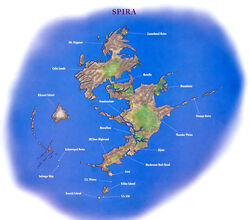
Spira is a continent resembling a large island. In terms of climate, Spira ranges from tropical islands (Besaid and Kilika) and a scorching desert (Bikanel Island) to temperate towns (Luca) and the icy Mt. Gagazet. Spira's population is made up of a variety of six races: humans divided into Spirians and the outcast Al Bhed faction, Hypello, Cactuars, Ronso, and Guado.
The world is terrorized by a supernatural monster the people call Sin that appears invincible. The temple of Yevon teaches that the monster is a physical manifestation of mankind's sins, and following the temple's teachings and atoning could purge it. Sin has been plaguing the world for a thousand years, the only moments of respite from its horrors being the short and temporary Calms brought upon by summoners who embark on dangerous pilgrimages to visit the temples of Spira to attain the Final Aeon, a magical creature of legend said to be strong enough to destroy Sin.
The aeons are supernatural creatures called forth at the behest of summoners, and manifestations of the fayth's dreams: human souls trapped in statues that reside in the temples of Yevon. Yevon was a powerful ancient summoner whose teachings people now follow to purge the world of Sin, which includes subservience to the temples and ban on all machina. When the religion of Yevon arose in the Machina War's aftermath a thousand years ago, summoning became one of its core dogmas. Yet, after every successful Final Summoning by a summoner who completes their pilgrimage, Sin always returns.
Characters [ ]
There are seven main playable characters and one temporary guest character.
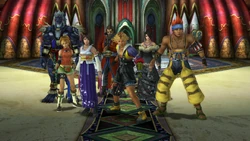
The main cast.
- Tidus - The main male protagonist, a rising blitzball player who is sent to Spira following the destruction of his hometown. With seemingly no way of knowing what has happened to him, he becomes guardian to Yuna on her pilgrimage to learn about the conflict he has been dragged into. Tidus can be renamed, and no character refers to him by name.
- Yuna - The main female protagonist, a summoner on a pilgrimage to defeat Sin, accompanied by her guardians. She is armed with great power and determination as she learns how she can save the tortured world.
- Auron - A mysterious man who watches out for Tidus and Yuna. He has been hailed as a legendary guardian, due to accompanying Lord Braska on his pilgrimage ten years ago. His seemingly cynical nature hides the truth he witnessed then.
- Kimahri - The only non-human member of the party who befriended Yuna when she was a child and has guarded her ever since. Though disgraced by his tribe of Ronso, Kimahri wishes for nothing more than to keep Yuna safe.
- Wakka - One of Yuna's childhood friends from Besaid. As captain of the infamously-pathetic Besaid Aurochs blitzball team, he has resolved to retire from the sport and join Yuna on her pilgrimage, bringing along his good-willed cheer.
- Lulu - One of Yuna's childhood friends from Besaid. A black mage who had accompanied summoners on their failed pilgrimages, she is knowledgeable of the world of Spira, and frequently scolds others to show her concern for her companions' safety.
- Rikku - A spunky Al Bhed girl, and the first person Tidus encounters upon arriving in Spira. Though considered a heathen among the majority of Spira's population, she only desires to protect Yuna, although her means of doing so sometimes conflict with the goals of the rest of the party.
- Guest characters
- Seymour Guado - A half-human and half-Guado, Maester of Yevon, and leader of the Guado. Seymour is well-liked and skilled in the art of summoning, but his ideas on what is best for Spira are questionable.
Story [ ]
Tidus is a blitzball player in a glittering metropolis known as Zanarkand. During the Memorial Cup to honor Tidus's father Jecht, a legendary player who went missing ten years ago, the stadium is destroyed by a colossal monster that attacks the city. Tidus is swept away along with Auron, a man who has been looking after him ever since Jecht went missing and Tidus's mother died, leaving him orphaned.
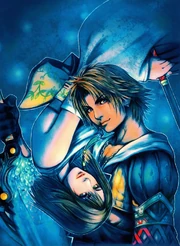
Artwork of Tidus and Yuna by Tetsuya Nomura.
Tidus awakens in an alien world called Spira where he meets people whose language he doesn't understand, and meets islanders whose customs he is unfamiliar with. The only thing he recognizes is blitzball, and the locals want to add him to their team after witnessing his skills. Under the care of his new friends, Tidus meets summoner Yuna who sets out on her pilgrimage to defeat Sin, the monster who had attacked Zanarkand and apparently transported Tidus into the future, as the only knowledge of Zanarkand Spirans have is a holy land that was destroyed by Sin a thousand years ago.
As Yuna's pilgrimage is to end there, Tidus joins her journey as her newest guardian, alongside Auron whom he runs into later. Tidus learns that when Jecht disappeared from Zanarkand he had run into Sin and arrived in Spira, the same as has happened to him, but can hardly believe it when Auron claims that Jecht has become the monster Sin itself.
During his travels Tidus falls in love with Yuna, who has attracted the attention of fellow summoners and a Maester of Yevon—the main religion in Spira—Seymour Guado. Yuna is captured and forced to marry him when Seymour becomes an unsent, a ghost whose soul should have departed to the land of Spira's afterlife: the Farplane. Tidus saves Yuna with the help of Yuna's other guardians and the Al Bhed, a tribe of Spirans who don't follow Yevon's teachings. Yuna resolves to continue the pilgrimage even after being branded a traitor. By this time Tidus has learned that if Yuna goes through with the ritual known as the Final Summoning to defeat Sin, she will die, but decides to stay by her side and support her.
Tidus is contacted by the fayth and learns the Zanarkand he hails from is but a dream of the fayth willed into being by an ancient summoner called Yu Yevon who created Sin as his armor a thousand years ago. The fayth ask Tidus to fell Yu Yevon so they can stop dreaming, and Tidus decides to help despite knowing that if the dream ends, he will disappear. In the ruins of the real Zanarkand, Yuna discovers the truth behind the Final Summoning: she must choose one of her guardians to become a fayth for the Final Aeon, but even if she were to succeed Yu Yevon would make the Final Aeon into a new Sin. This is how the current incarnation of Sin is actually Jecht, Tidus's father. After arriving in Spira Jecht had become a guardian for Lord Braska, Yuna's father, and offered to become his Final Aeon. The party learns that Auron was killed by Yu Yevon's unsent daughter Yunalesca when he sought to avenge Jecht and Braska, and has been wandering as an unsent ever since. Yuna, meanwhile, declares the Final Summoning a false rite and refuses to go through with it.
Using the Al Bhed's airship the party attacks Sin head on and ventures inside it, where they find Jecht in his Final Aeon form who asks Tidus to destroy him. Afterward Yu Yevon manifests and the party kills him. Yuna sends Auron, the aeons, and Sin to the Farplane. The fayth statues lose their power, and Dream Zanarkand and all its inhabitants, Tidus included, disappear from Spira.
Spoilers end here.
Themes [ ]
The Final Fantasy series had always had somewhat of a "foreign" feel from the Japanese point of view, the first games taking place in a medieval "European" setting. When the settings moved toward a more modern atmosphere, foreign influence was still strong with Final Fantasy VII originally imagined to take place in the real life New York City, and many locations in Final Fantasy VIII modeled after real world European locations.
Final Fantasy X is a break by being pointedly South East Asian in its feel, most notably with respect to vegetation, topography, architecture, and names. Producer Yoshinori Kitase felt that if the setting returned to a medieval European fantasy, it would not help the series advance. While he was brainstorming different world environments, scenario writer Kazushige Nojima suggested a fantasy world that incorporated Asian elements. Many fans had responded negatively to the sci-fi elements of some previous Final Fantasy games, and with Final Fantasy X the developers wanted to expand the fans' definition of the word "fantasy" by taking a different route from the "medieval Europe" fantasy setting so commonly seen in RPGs.[11] A number of the development staff spent time in South East Asia, such as Bali and Thailand, and brought back influences to incorporate into Spira.[12]
Final Fantasy X is the first Final Fantasy game to have its theme song sung in Japanese, and instead of being a pop song, "Suteki Da Ne (Isn't It Wonderful?)" is a traditional Japanese folk song. The intention to capture an Asian feel is also evident in the character designs, with the basis for Yuna's design being that of Okinawan kimonos; the specific type of kimono chosen for her is a furisode. Yuna's dress and necklace are adorned with images of the hibiscus flower also called "yuna", and Tidus's Japanese name (ティーダ) translates to "sun" (太陽) in Okinawan. Japanese influences are also seen in Lulu's hairstyle and Auron's samurai concept. The concepts of aeons, fayth, pyreflies, sending, and unsent all hearken to Asian legends and traditions.
Yoshinori Kitase has stated the game's main theme is "journey", but that in addition there are many hidden themes.[11] He stated that as a father the theme of family is closest to his heart. When the project had just started, writer Kazushige Nojima had just read several collections on kamikaze pilots and their families. Among them were stories of the pilots' families seeing them off, worrying about their health, even though they knew that the pilots were going to die. This kind of resolve and resignation formed the core of X's story.[13]
Another central theme is legacy, in how both Tidus and Yuna follow in their fathers' footsteps. Tidus had grown up in his father's shadow and becomes a renowned blitzball star like Jecht was. Yuna follows in her father's example by becoming a summoner. Years after Jecht and Braska sacrifice themselves, their children follow the same path, but the revelations they uncover along the way force Tidus, Yuna, and their friends to find a new path and free Spira.
Further themed is the Japanese Buddhist religious concepts of jiriki (lit. "self power") and tanriki (lit. "outside power"), said to be the powers that one may choose to follow to become enlightened and ultimately achieve Nirvana once set in a school's teachings. The school of Jodo Shinshu, long empathizing tanriki, sees its historical and cultural influence greatly in the aspects of Yevon; from having a military power, ensuring that the people follow its zeal to have the populace under its teachings, and ultimately, obedient unwavering command, and to bearing influence on political scale, sometimes to the point of corruption.
Another central theme is Gnosticism, a eletist movement in the early Christian Church that was rejected as heresy. Gnostics believed all material existence, including the human body itself, to be sinful, and that the material world was created by an evil god. The word "gnosis" (Greek: γνῶσις) means "knowledge," denoting a special "hidden knowledge" about the world and about Christian doctrine that only a select few were privileged to know. The Gnostics believed it was this "hidden knowledge" about the world that freed them from the confines of the body and material existence, uniting them to the spiritual realm created by the evil god of the Old Testament, whom they believed unenlightened Christians unknowingly worshiped.
Spirans believe Sin is their rightful punishment for their vanity and that because mankind is sinful, Sin is continually reborn. Death is glorified with the summoners sacrificing themselves to summon the Final Aeon, with the aeons themselves being the spirits of the dead. Those who do not find their way to the Farplane become twisted by the envy they feel toward the living and eventually turn into fiends.
The word aeon is derived from the Koine Greek word ὁ αἰών, meaning "age", "forever", or "for eternity". In Gnostic lore, it denotes the immaterial emanations of God. Yu Yevon can be viewed as the "evil god" from Gnostic lore, known as Yaldabaoth in Gnostic religions, from whom mankind must be saved. Although Yu Yevon is not a true god in Final Fantasy X, not having created the world and the people in it, but merely having created Dream Zanarkand and Sin, it is still worshiped in the Yevon religion in a similar way in which the Gnostics believed Yaldabaoth was unknowingly mistaken by the Christian Church for the supreme God, and worshiped as such.
Tidus is introduced to the world as someone who can see Spira's ways of life as it really is: false. By getting to know Tidus and believing in his Zanarkand, Yuna comes around to his way of thinking, and at the crucial moment rejects the Final Summoning as a false rite. The Gnostic belief of the "hidden knowledge" about the world being the way to save them, is represented in the game by the discovery of truth behind Sin, Yevon, and the Final Summoning. Once the hidden truth behind Yevon is revealed, Yuna and her friends seek to find a permanent way to vanquish Sin and give the people of Spira a future of independence from Yevon.
Tidus further acts as a Gnostic Christ figure. The Gnostics, rather than believing Jesus Christ to be God the Son, the second Person of a Triune Godhead incarnate, believed him to be a spirit sent from a higher spiritual plane than that of Yaldabaoth, who came to teach the world about the one supreme transcendent God—different from the God of the Old Testament, whom Gnostics believed was actually the lesser, malevolent deity Yaldabaoth, who created all physical matter—and to free humankind from the illusion that was the physical world. Much similarly, Tidus's very existence is an illusion, as is the world he comes from.
The game highlights the belief that religion is a manmade, or at least, cultivated concept, and how customs can change from their original interpretations over time. The blitzball salute, originally a gesture of respect and greeting in the past for a sport, becomes the Yevon faith's salute. Machina, once used commonly by Bevelle, is stigmatized and cast down as heresy. The faith of Yevon finds itself not of a supernatural and divine origin, but ultimately one founded by man and whose spiritual protectors and entities are those of martyrs who were once human.
Spoilers end here.
Music [ ]
Final Fantasy X is the first numbered Final Fantasy game to feature a musical score not completely credited to Nobuo Uematsu, who has written the music for Final Fantasy since its inception. The game's soundtrack was co-scored by Junya Nakano and Masashi Hamauzu.
The game's main theme, "Zanarkand", is heard in the beginning and in multiple other forms during the game's main events. Another prominently featured song is the vocal theme "Suteki Da Ne (Isn't It Wonderful?)", played during the romantic scene between Yuna and Tidus at the lake in Macalania Woods. Many tracks also have the instrumental form of this song mixed into them, such as "Yuna's Theme" and "Spira Unplugged".
Other popular songs include "Otherworld", played in the beginning of the game and during the final battle, and the "Hymn of the Fayth", sang in a different way in each temple by each fayth, and by many characters, such as the Al Bhed and even hummed by Tidus.
Development [ ]
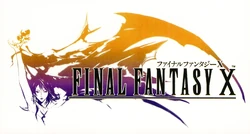
Original logo. Yuna's face is on the left with her right hand raised, and possibly the profile of an aeon or Sin in the background.
Development began in 1999. The game was first presented at the 2000 Square Millennium Event together with Final Fantasy IX and Final Fantasy XI, although this early version greatly differs from the final game. Although Hironobu Sakaguchi showed doubts about the transition from 2D to 3D backgrounds, voice acting, and real-time storytelling, he also stated the success of the series was due to constantly changing development and trying out new things. Development for Final Fantasy X cost approximately four billion Japanese yen (approximately 32.3 million dollars),[14] with a crew of more than 100 people, most of who worked on previous games in the series.
Graphics [ ]
Though PlayStation 2 was a leap in power over the original PlayStation, the limit to the hardware specs meant the developers had to choose whether to prioritize resolution or the number of colors. Initially, the team thought depicting more color would help bring the world of Spira to life, but during development it became clear that other games released during the time all prioritized resolution, and fans' expectation was for higher resolution games. The developers pivoted with increasing resolution in the last six months of development, which meant major last minute modifications.[15]
Final Fantasy X was the first game in the series to not include a world map because it was to be in full 3D, and a world map module was deemed expensive.[15]
Gameplay [ ]
Final Fantasy X was initially going to incorporate online elements, which were later dropped, and added into the next title in the series. In a beta video shown at the Square Millennium Event in 2000, Tidus has black hair, and the game appears perfectly 3D with the player being able to rotate the camera. Tidus's character model in the demo is more detailed with his clothes and hair bouncing as he moves and also fluttering in the wind. The menu showed Tidus and Yuna with levels akin to previous Final Fantasy games, rather than sphere levels like in the final game. Director Yoshinori Kitase was a fan of board games and wanted to recreate the sensation of moving pieces and filling up the board with them.[15]
The Conditional Turn-Based Battle (CTB) was a new battle system replacing the Active-Time Battle (ATB) system from previous titles. The traditional world map concept was dropped, because the developers wanted a more realistic approach, as well as realism of the game's 3D backgrounds and character animation. Originally, Final Fantasy X was going to feature enemies wandering visible on the field map with seamless transition into battles allowing players to move freely around the area during enemy encounters. Battle art director Shintaro Takai has explained the intention was for the battles to come across as a natural part of the story instead of an independent element.

However, due to hardware and system limitations, these ideas were not used until Final Fantasy XI and Final Fantasy XII. Final Fantasy X uses a compromise from the original ideas, with some transitions from the field screen to battle arenas relatively seamless, only with the implementation of a motion blur effect. The desire for seamless transitions also led to the implementation of the new summoning system.
The game takes place on a journey from the village of Besaid to Zanarkand with little side-tracking, and to broaden the range of what the players can enjoy, many minigames were incorporated. There were close to 10 people handling this aspect, and Yoshinori Kitase left it up to their imagination to come up with ideas.[16]
Voice acting [ ]
Yoshinori Kitase has cited the inclusion of voice acting as one of the big things he wanted to introduce to Final Fantasy when the series moved from PlayStation to PlayStation 2.[17] As the previous games had only had text, the depth of expression available was broadened by the introduction of voice, but on the other hand, by giving characters actual voices, their facial expressions became more important, and the developers needed to invest more energy into that.[17]
The characters' facial expressions were achieved through motion capture and skeletal animation technology, which allowed animators to create realistic lip movements programmed to match the speech of the game's voice actors. Scenario writer Kazushige Nojima has revealed the inclusion of voice acting enabled him to express emotion more powerfully than before, and he was therefore able to keep the storyline simple. The presence of voice actors led to various changes to the script to match the voice actors' personalities with the characters they were portraying.
Localization [ ]
The inclusion of voice led to difficulties; with the game's cutscenes already programmed around the Japanese voice work, the English localization team struggled incorporating the translated script with the rhythm and timing of the characters' lip movements, and almost all of it had to be rewritten to better match the lip animations.[18]
The localization voice director, Jack Fletcher, had asked several months before the project began whether there was going to be ADR recording to lip flaps, and had been told by someone at Square Hawaii—who had been working as a go-between—that there would not be syncing to lips. The video that he had received at that point, a few months before recording began, was a rough cut without proper lip animations.[19]
The majority of the English dialogue was not based to the actual game footage; the only guidance the voice actors had were samples of the original Japanese dialogue, and they rarely had the opportunity to sync their dialogue with actual footage. Once the voice recording was complete, sound editors would digitally speed up or slow down the audio clips to fill the character's allotted speaking time for each particular line, because the lengths of audio files were hardcoded the game engine triggering actions and sound files concurrently, so changing the length of a sound file would break the game.[18] The way that the game engine was triggering sound files was tied into the same system used to trigger action on the screen, so if a sound file went overboard by even half a second, it could throw off the entire scene and even crash the game.[19]
The team tried to mask the file constraints the best they could, but that was not the only issue: The Japanese idea of dramatic writing is to speak slowly. This reflected in Yuna's cadence in some parts with long pauses between words. Some parts like this were covered by having the character ask themselves a question and then answer it, making the pause sound more natural.[18]
The head of localization, Alexander O. Smith, pushed for the change for Yuna's final words to Tidus in the ending from Arigato (thank you) to "I love you" despite resistance from the Japanese side of development. "I love you" had never appeared in a Final Fantasy game before because it's not something Japanese usually say.[18]
Storyline [ ]
In terms of setting, scenario writer Kazushige Nojima suggested that the game utilize an Asian flavor to shift away from the paradigm of the last three games, which had depicted western/futuristic worlds.[20]
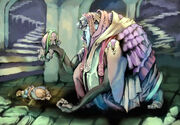
Early concept designs.
The original concept was that "a person would reach the end of life at 17 years of age". That theme of "inevitable death" was carried over to become Yuna's fate.[16] In Final Fantasy X Ultimania Omega creators' interview, it is mentioned one of the early premises was having a deadly illness running rampant in the world with Yuna as a nurse following Yevon's teachings treating people while on a pilgrimage. Yevon was a "Red Cross-like organization" with Mika as its chairman. Yuna would have failed to heal the people and it would turn out that the method of treatment itself was leading to the people's deaths.
Kazushige Nojima was initially concerned with establishing a connection between the player and main character and the story was designed so the player's progress through the world and growing knowledge about it is reflected in Tidus's narration. In the early story drafts Tidus's role was vastly different from the final version; Tidus was envisioned as a plumber with the attitude of a delinquent.[21]
The original plans for the game's opening scenario were wildly different from the final version.[21] In the early drafts Tidus would have been swimming around the ocean near Registan (later renamed Zanarkand) to the theme of "Hymn of Fayth", then visiting a place called "Yevon Dome" where Tidus would have met up with his friends, a male and two females. They would have checked the time and thought it was getting late. The Yevon Dome would have been a place where the founder of Registan, Yevon, would have been worshiped, it was a large bowl-shaped arena where Registan's populace would come to meet with friends and offer up their prayers.
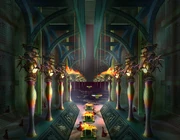
Early concept designs.
The people would have prayed daily to Yevon, but although Yevon would have been deified in Registan, it was not a religion. Tidus would have descended to the underwater facility of Registan where he would have fought an underwater boss. Upon leaving the facility Sin would have risen from the ocean and Tidus would have let it pass with a smile. The scene would have ended with Tidus glancing at his wristwatch and worrying about it being so late.
Monsters would have begun attacking the city but Auron and the Crimson Blades would have fought them off. Before it was decided Auron would be an unsent, he was envisioned working as a Crimson Blade exterminating monsters in Registan. There were also plans to make Tidus the unsent, but due to the release of the film Sixth Sense with a similar plotline, the storyline was given to Auron. There were also plans of having Auron be Jecht in disguise. This way, Jecht could have been watching things all along, but because the developers didn't want Jecht to have a leading part in the game, they gave up on the idea.[22]
Sin was created to be a presence Spirans could simply not avoid, however much they tried. Yoshinori Kitase created it to represent the kinds of calamitous disasters that exist in the real world, such as earthquakes and typhoons. Spira has the teachings of Yevon, which give meaning to people's lives in the face of death, so what Kitase tried to show in Final Fantasy X was how people behave in the face of unavoidable fate.[17]
The process of acquiring each of the aeons was made an important element to the story. This importance placed on them made the developers invest in their design. What differentiates Final Fantasy X from its predecessors is the interplay between the summoner and the summoned monster, such as how Yuna will pat Valefor's head during her summoning animation. Emphasizing the relationship between Yuna and the aeons gave the game's final scene, where she must part with them, even more impact.[17]
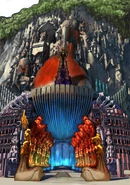
Early concept designs.
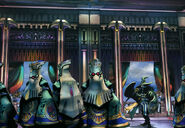
Early concept designs.
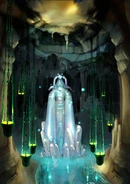
Early concept designs.
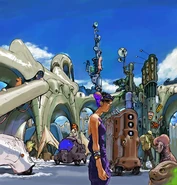
Early concept designs.
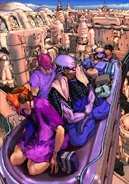
Early concept designs.
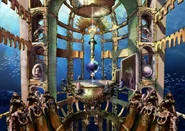
Early concept designs.
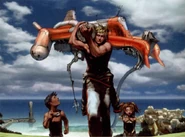
Early concept designs.
Leaked version [ ]
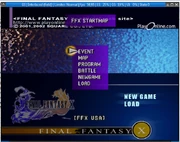
Menu of the preview build of Final Fantasy X.
In May 2009 a preview-build of the North American version was leaked online. This build is from about two months before the final release. It has a debug mode at the main menu, and the FMVs are in Japanese with English subtitles.
Pressing ![]() during gameplay brings up debug info, and there are plenty of humorous scenes and settings that were never supposed to make it into the final game. The leaked version has grayed out loading options in the config: either "HDD" or "DVD-ROM". There is also an HDD option in the main menu.
during gameplay brings up debug info, and there are plenty of humorous scenes and settings that were never supposed to make it into the final game. The leaked version has grayed out loading options in the config: either "HDD" or "DVD-ROM". There is also an HDD option in the main menu.
Releases [ ]
Final Fantasy X: International [ ]
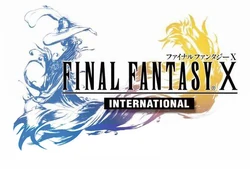
The International Version was released in Japan on January 31, 2002, and later in Europe (the European release was simply titled Final Fantasy X). This updated version has different box art for Japan, and new features, such as an Expert Sphere Grid, which allows for accessing abilities more easily, but less overall stat-growth. New abilities were added to both Standard and Expert Grids.
The Dark Aeons and Penance, all powerful superbosses, were added, as well as many minor changes to dialogue, scenes, the Celestial Weapons' key items (Japan only), characters and armor, weapon customizations, such as Ribbon. The release also includes a bonus disc with behind the scenes making-of features of Final Fantasy X, and a Final Fantasy X: Eternal Calm, a special movie prologue to Final Fantasy X-2.
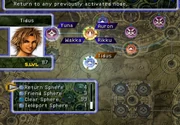
Expert Sphere Grid in the International version.
The European release has the the Dark Aeons and Penance, as well as the new equipment abilities, but didn't change the name of the Celestial Sigils and Crests. As with previous PAL conversions of Final Fantasy installments, the game has black borders and a slower running-speed as a result of poor PAL conversion. The black label version includes a bonus DVD with the title Beyond Final Fantasy, which includes various interviews with the game developers, as well as two of the English voice actors. It also includes trailers of various Square games, an art gallery, short biographies on Nobuo Uematsu and RIKKI, as well as a music video of RIKKI performing "Suteki da ne".
Some versions of Final Fantasy X: International have a glitch, whereby if the player goes to the area where they fight Dark Ifrit it is possible to slip past the men blocking the way to Home, and thus, be able to return to the story at the events in Home with Yuna in the party. This glitch can be repeated after the first time it is used.
Square Enix re-released Final Fantasy X as a debut title for its "Ultimate Hits" range alongside Final Fantasy X-2 in Japan. They also released the Ultimate Hits editions of the two titles collectively in the Final Fantasy X/X-2 Ultimate Box along with Final Fantasy X: Eternal Calm.
Final Fantasy X/X-2 HD Remaster [ ]

Final Fantasy X was the first Final Fantasy game originally developed for a Sony platform to be remastered. A high-definition port was announced at the Sony Press Conference in Japan on September 14th, 2011 as part of a 10th anniversary special, and was set to be released on the PlayStation 3 and PlayStation Vita. This version is based on the International version, making it the first time the features exclusive to that version are officially available in North America. The HD remaster has trophies.
On 19 March, 2013, it was confirmed Final Fantasy X-2 was also receiving an HD remastering and that it, too, would be based on its International version. The two games are available together on a single Blu-ray disc for the PlayStation 3 version, but on PlayStation Vita Final Fantasy X-2 is available only digitally, but its code is included in the Final Fantasy X retail version so that the buyer can still get both.
It was released in Japan on December 26, 2013 and March 18, 2014 overseas.
Microsoft Windows (via Steam) [ ]
Final Fantasy X/X-2 HD Remaster was listed in Steam's database in December 2015.[23] It was released on May 12, 2016.[5]
iOS and Android [ ]
Final Fantasy X/X-2 HD Remaster was released in November 16th, 2017 on iOS and Android via the G-Cluster game streaming service.
Xbox One, Xbox Series X|S, Windows 10 [ ]
Final Fantasy X/X-2 HD Remaster was released to Xbox consoles and Windows 10 via Xbox Game Pass.[24]
Reception [ ]
Critical reception [ ]
| Aggregator | Score |
|---|---|
| Metacritic | PS2: 92/100 (53 reviews) [8] |
| Publisher | Score |
| Eurogamer | 9/10[25] |
| Famitsu | 39/40[26] |
| Game Informer | 9.75/10[27] |
| GameSpot | 9.3/10[28] |
| IGN | 9.5/10[29] |
Final Fantasy X received generally high review scores in both Japanese and western media. Critics generally praised the game's storyline, graphics and movies, although some criticized the game's dialogue and linearity, as well as the Sphere Grid leveling system and unskippable cutscenes.[25] [27] [28] [29]
Many reviewers praised the story. Game Informer claimed the story was less predictable than previous games', saying it "feeds off of your emotions, stabs you in the back, and takes your breath away".[27] GameSpot similarly says it weaves an "engrossing, memorable story filled with a number of great characters", but noted that not everyone will take to its "metaphysical story".[28] Eurogamer claimed that the characters "make much more dignified and believable decisions than those made by their predecessors".[25] IGN noted that telling the story through spoken dialogue was a "potentially dangerous step" if the voice acting was poor, but that though not a "perfect piece of acting and direction", it works "far better than you'd expect a first effort to".[29]
Critics also praised the presentation, with many comparing its visual style through the artwork to Final Fantasy VIII.[28] [29] Eurogamer called the character design and animation "stronger than anywhere else in the series", and claimed that the game is "transformed into more of a movie than a game at times" due in part to the characters' "high standards of their artwork, specifically facial animation and body language".[25] GameSpot said that "you can tell a huge team of artists worked on the game because not all of the graphics look consistent".[28] IGN said that the game's graphics had little competition, with the exception of Metal Gear Solid 2: Sons of Liberty, which it called "hardly a fair comparison" due to it being confined to "shades of gray and brown most of the time", as opposed to the freedom to use a broader color palette in Final Fantasy.[29]
Many critics praised the gameplay, but were divided on the linear structure. IGN concluded that the gameplay was a "leap ahead" of recent titles, calling the combat system "blazing fast and far more versatile" and saying that the Sphere Grid is a"major break with the past, but one that does work well", giving the gameplay a score of 9.6/10.[29] GameSpot praised the Sphere Grid and combat, but claimed that the linearity would "alarm a hard-core fan of role-playing games", but notes that the game does not fall into the categories of being too short or requiring constant backtracking, and noted advantages linearity brought in terms of the narrative.[28] Game Informer claimed that the linear structure was the "only complaint" they had and missed "having the freedom to leisurely move about the world, perhaps on the back of a chocobo" from previous titles.[27]
Famitsu readers voted Final Fantasy X the best game of all time in early 2006 and Producer Shinji Hashimoto stated in 2002: "We've had a great reception from the media and already received some awards and so forth, so overall the reaction has been excellent".[30] On December 3, 2014 Final Fantasy X was voted by the Japanese fans as one of the best five PlayStation games of the brand's 20 years lifespan, along with Final Fantasy VII, Grand Theft Auto V, Metal Gear Solid 3: Snake Eater, and Monster Hunter Freedom Unite.[31]
Commercial performance [ ]
Within four days of its release in Japan, the game had sold over 1.4 million copies in preorders, which set a record for the fastest-selling console RPG.[32] In 2004, Square Enix announced that Final Fantasy X had sold 6.6 million copies worldwide.[9] In 2013, Square Enix announced that the Final Fantasy X series had sold over 14 million copies.[10]
Legacy [ ]
Final Fantasy X was the first Final Fantasy game to get a direct sequel game, and Final Fantasy X-2 was released two years later, in 2003. Final Fantasy X wasn't originally planned to have a sequel, but after a strong fan reaction to the short story titled "Final Fantasy X: Eternal Calm" included with Final Fantasy X International, the development team decided to continue the story in a sequel.[33]
In an interview in the Final Fantasy X|X-2 HD Ultimania published the same time the Final Fantasy X/X-2 HD Remaster set came out in Japan, 26th December 2013, Kazushige Nojima, the scenario writer for Final Fantasy X and Final Fantasy X-2, hinted at possible future developments for the world of Spira: "If there's enough demand, then we may possibly see new developments. [...] I would personally like to see a sequel like X-3".
Dialogue translated from the Final Fantasy X/X-2 HD Remaster post-credits audio drama Final Fantasy X -Will-, and Nojima's spin-off novella Final Fantasy X-2.5 ~Eien no Daishou~, leave open new plot threads, further hinting at a future sequel, but Square Enix has not announced one.
Production credits [ ]
Staff [ ]
| Producer | Yoshinori Kitase |
|---|---|
| Directors | Motomu Toriyama (event), Takayoshi Nakazato (map), Toshirō Tsuchida (battle) |
| Sound Producer & Music | Nobuo Uematsu |
| Main Programmers | Koji Sugimoto (character), Takashi Katano (event) |
| Image Illustrator | Yoshitaka Amano |
| Program Supervisor | Ken Narita |
| Battle Programmer | Masaki Kobayashi |
| Character Designer | Tetsuya Nomura |
| Menu Programmer | Tomonari Ohnishi |
| Art Directors | Yusuke Naora (world), Shintaro Takai (battle) |
| Chief VFX Programmer | Yasunari Ohinishi |
| Real‑Time Graphics Director | Tomohiro Hasegawa |
| Monster Designer | Tetsu Tsukamoto |
| Scenario | Kazushige Nojima |
| Battle Motion Director | Shintaro Tamai |
| Field Programmers | Yukio Ishii, Chikara Yanagimachi |
| Field Motion Director | Go Kikuchi |
| Chief Art Designer | Tetsuya Takahashi |
| 3D Map Director | Yohichi Kubo |
| Lead Battlefield Designer | Tsuyoshi Okahisa |
| Movie Director | Hiroshi Kuwabara |
| Chief Storyboard Designer | Akira Oguro |
| Movie Programmer | Kengo Sasaoka |
| Music | Junya Nakano, Masashi Hamauzu |
| Sound Programmer | Minoru Akao |
| Supervising Dialogue Editor | Teruaki Sugawara |
| Chief Character & Motion Coordinator | Shinji Watanabe |
| Lead Field Designers | Yoshinori Ogura, Takaharu Matsuo, Shinichiro Hamasaka, Masayo Asano |
| Supervising Sound Editors | Eiji Nakamura, Chiharu Minekawa |
| CG Supervisor | Satoshi Tsukamoto |
| Production Executive | Yoichi Wada |
| Square Co., Ltd. | |
| Senior Vice President | Koji Yamashita |
| General Manager | Akira Kashiwagi |
| Localization Directors | Ichiro Nonaka, Kazuyoshi Tashiro |
| SquareSoft Inc. | |
| Localization Manager | Yutaka Sano |
| Senior Vice President | Yuji Shibata |
| Editor | Jennifer L. Mukai |
| Localization Specialists | Brody Phillips, Shigeto Matsushima, Ryosuke Taketomi, Rika Maruya |
Voice cast [ ]
| Character | Japanese | English |
|---|---|---|
| Tidus | Masakazu Morita | James Arnold Taylor |
| Yuna | Mayuko Aoki | Hedy Burress |
| Auron | Hideo Ishikawa | Matt McKenzie |
| Wakka | Kazuya Nakai | John DiMaggio |
| Lulu | Rio Natsuki | Paula Tiso |
| Kimahri Ronso | Katsumi Cho | John DiMaggio |
| Rikku | Marika Matsumoto | Tara Strong |
| Seymour Guado | Junichi Suwabe | Alex Fernandez |
| Jecht | Masuo Amada | Gregg Berger |
| Cid | Koichi Sakaguchi | Michael McShane |
| Lord Braska | Takuma Suzuki | Andrew Philpot |
| Yo Mika | Hiroshi Iwasaki | Dwight Schultz |
| Wen Kinoc | Hidenari Ugaki | Roger L. Jackson |
| Kelk Ronso | Koichi Sakaguchi | Corey Burton |
| Luzzu | Ryuzo Ishino | John DeMita |
| Gatta | Hiroshi Kamiya | Adam Paul |
| Lucil | Sayaka Ohara | Candi Milo |
| Elma | Sumomo Momomori | Julia Fletcher |
| Clasko | Takayuki Yamaguchi | Matt Miller |
| Dona | Nanaho Katsuragi | Candi Milo |
| Barthello | Jun Ishimaru | John DeMita |
| Isaaru | Akio Suyama | Quinton Flynn |
| Maroda | Masataka Nakai | Robbie Rist |
| Pacce | Motoko Kumai | Candi Milo |
| Belgemine | Kayoko Fujii | Cree Summer |
| Brother | Takayuki Yamaguchi | David Rasner |
| Maechen | Takuma Suzuki | Dwight Schultz |
| Shelinda | Miki Nagasawa | Sherry Lynn |
| Rin | Shunsuke Sakuya | Tom Kenny |
| O'aka XXIII | Hidenari Ugaki | Dwight Schultz |
| Wantz | Takayuki Yamaguchi | Tom Kenny |
| Tromell | Ryuzo Ishino | Corey Burton |
| Zuke | Jun Ishimaru | André Sogliuzzo |
| Bahamut's Fayth | Rio Natsuki | Debi Derryberry |
| Yunalesca | Yōko Koyanagi | Julia Fletcher |
Motion cast [ ]
| Character | Actor |
|---|---|
| Tidus | Masakazu Morita |
| Yuna | Mayuko Aoki |
| Wakka | Akihiko Kikuma |
| Lulu | Yoko Yoshida |
| Kimahri Ronso | Tesshin Murata |
| Auron | Jun Ishii |
| Rikku | Miyuki Shimizu |
| Seymour Guado | Ichiro Kato |
| Jecht | Hideki Yamazaki |
| Sub characters | Yasuko Fujinami |
Packaging artwork [ ]
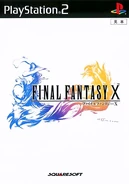
Japan.
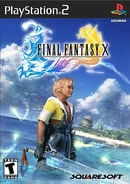
North America.
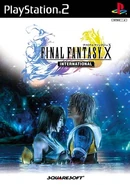
"International".
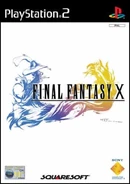
PAL.
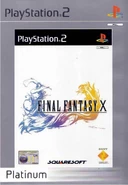
PAL (Platinum).

Greatest Hits North America.
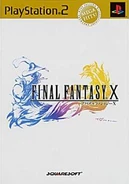
Mega Hits Japan.
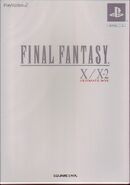
Ultimate Box rerelease bundle, includes Final Fantasy X-2 Japan exclusive.

Ultimate Hits Japan.
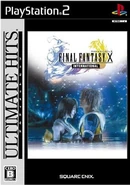
International Ultimate Hits Japan.

PS3 North American.
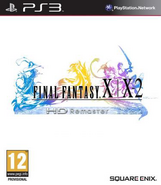
PS3 European.

PS3 North American Limited Edition.

PS3 Japanese.

PS Vita North American bundle.
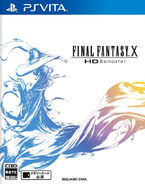
PS Vita Japanese Final Fantasy X.
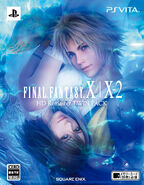
PS Vita Japanese Twin Pack.

PS4 European.
![]()
iOS and Android icon.
Gallery [ ]
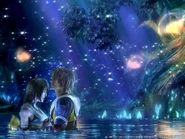
Promotional poster.
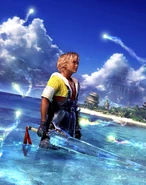
Promotional poster.
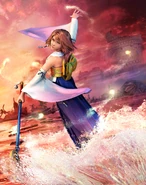
Promotional poster.
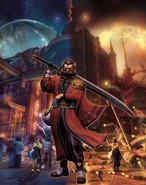
Promotional poster.
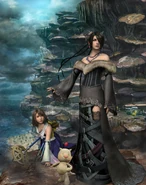
Promotional poster.
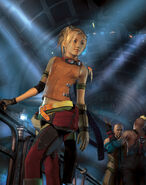
Promotional poster.
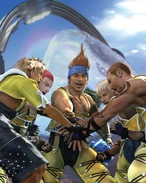
Promotional poster.

Promotional poster.
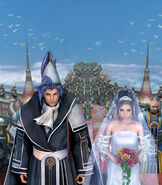
Promotional poster.
Allusions [ ]
Final Fantasy X contains allusions to previous games and Asian mythologies.
Trivia [ ]
- In the game's title logo, the roman numeral 'X' is written in a different typeface to the traditional Runic Font MT used in other logos.
- In the title logo for Final Fantasy X|X-2 HD Remaster, the roman numeral 'X' has been reverted to the Runic Font MT typeface.
- In a Famitsu popularity poll, four characters from Final Fantasy X (Yuna, Tidus, Auron, Rikku) made the top 50. This is the second most characters from one game, with the most being from Final Fantasy VII.
- Blood is seen in only a few scenes throughout the game: caused by Geosgaeno's attack on a sahagin at Baaj Temple near the beginning, during the underwater scene when Tidus is attacked by Sinscales, running down the left side of the aeon Anima's face from her left eye in the Luca FMV in which she is summoned, on the sand in the aftermath of Operation Mi'ihen, and during the raid on Home.
- During the entirety of Final Fantasy X, Tidus's name is not spoken by the other characters. This was because of a choice of the player to rename the main character.
- Final Fantasy X-2 continues this option despite Tidus being a non-playable character and is referenced as "Star Player of the Zanarkand Abes" in the blitzball minigame.
- Kingdom Hearts breaks this pattern with Wakka speaking Tidus's name during a cutscene. However, Tidus is not a playable character.
- In the poll in which Famitsu asked its readers what games made Japanese gamers cry, Final Fantasy X topped the chart as the number 1 game.[34]
- Final Fantasy X was referenced in the popular sitcom Two and a Half Men. Jake rented the game from a rental store, though later in the episode, when Jake is supposedly playing the game, the music heard is the battle theme from Final Fantasy II.[35]
- Final Fantasy X was referenced in the Thomas Pynchon novel Bleeding Edge with regard to the game's exceptional graphics.
See also [ ]
- Final Fantasy X Playable Demo
- Final Fantasy X Allusions
- Final Fantasy X Concept Art
- Final Fantasy X Translations
- Final Fantasy X Timeline
- Final Fantasy X Wallpapers
External links [ ]
- Official North American Site
- Official Final Fantasy X|X-2 HD Remaster Site
- Official Final Fantasy X|X-2 HD Remaster North American Facebook Page
- Official European Site
- Steam Purchase Page
- Playstation Store PS3 Purchase Page
- Playstation Store PS4 Purchase Page
- Playstation Store PS Vita Purchase Page
- iTunes Purchase Page
- Google Play Purchase Page
- Amazon Purchase Page
- Wikipedia Article
- Final Fantasy X Screenshots
References [ ]
- ↑ 1.0 1.1 1.2 1.3 Final Fantasy X/X-2 HD Release Date Announced
- ↑ http://www.siliconera.com/2015/03/02/final-fantasy-xx-2-hd-remaster-arrives-ps4-may-new-music-switching-option/
- ↑ http://www.jp.square-enix.com/ffx_x-2HD/
- ↑ 4.0 4.1 http://eu.square-enix.com/en/blog/final-fantasy-xx-2-coming-ps4-15th-may-exclusive-steelbook
- ↑ 5.0 5.1 http://store.steampowered.com/app/359870
- ↑ https://www.nintendo.com/games/detail/final-fantasy-x-x-2-hd-remaster-switch/
- ↑ https://news.xbox.com/en-us/2019/04/16/final-fantasy-x-hd-remastered-xbox-one/
- ↑ 8.0 8.1 Final Fantasy X for PlayStation 2 (Accessed: July 29, 2018) at Metacritic
- ↑ 9.0 9.1 Final Fantasy X-2 sells a million (Accessed: December 31, 2017) at GameSpot
- ↑ 10.0 10.1 "FINAL FANTASY X / X-2 HD Remaster" Release date and price determination announcement (Accessed: December 30, 2017) at Square Enix
- ↑ 11.0 11.1 "Beyond Final Fantasy" bonus DVD included in the International version of Final Fantasy X
- ↑ Interview with Final Fantasy Director Yoshinori Kitase and Art Director Yusuke Naora — Denkiphile.com
- ↑ (2021, July 28). "How kamikaze pilots inspired FFX – Final Fantasy X 20th Anniversary Developer Interview (Part 2/4)". From Frontline Gaming JP. Archived from the original on 1 August, 2021.
- ↑ Financial Fantasy X (Accessed: January 24, 2018) at RPGamer
- ↑ 15.0 15.1 15.2 Yoshinori Kitase (2022, January 5). "Final Fantasy X and X-2 producer reflects on the innovative PS2 titles". From PlayStation Blog. Archived from the original on 6 January, 2022.
- ↑ 16.0 16.1 Final Fantasy X's Original Idea And Other Reflections From Yoshinori Kitase (Accessed: July 24, 2019) at Siliconera
- ↑ 17.0 17.1 17.2 17.3 Final Fantasy 10: Kitase reveals the secrets of its success — Gamestm
- ↑ 18.0 18.1 18.2 18.3 EDGE #278 Tale of Tales Meet Alexander O Smith the translator who's brought some of Japan's biggest RPGs to the West p. 93-94
- ↑ 19.0 19.1 True Tales from Localization Hell (Accessed: July 29, 2018) at USGamer
- ↑ Looking Back On Final Fantasy X With Producer Yoshinori Kitase (Accessed: July 24, 2019) at Game Informer
- ↑ 21.0 21.1 Final Fantasy X Ultimania Omega, p.476-477 (Translation)
- ↑ Final Fantasy X Ultimania Omega, p.477 (Translation)
- ↑ https://steamdb.info/sub/64178/
- ↑ [1]
- ↑ 25.0 25.1 25.2 25.3 Final Fantasy X (Accessed: December 30, 2017) at Eurogamer
- ↑ Famitsu scores archive
- ↑ 27.0 27.1 27.2 27.3 Game Informer review (archived)
- ↑ 28.0 28.1 28.2 28.3 28.4 28.5 Final Fantasy X Review (Accessed: December 30, 2017) at GameSpot
- ↑ 29.0 29.1 29.2 29.3 29.4 29.5 Final Fantasy X Review (Accessed: December 30, 2017) at IGN
- ↑ Interview: Square invades London
- ↑ https://www.youtube.com/watch?v=ry1-0XwCAHk
- ↑ Final Fantasy X Sells Like Crazy; World Not Shocked (Accessed: December 30, 2017) at IGN
- ↑ Final Fantasy X-2 Developer Interview — IGN
- ↑ http://www.capsulecomputers.com.au/2012/01/famitsu-reveals-games-that-made-the-japanese-cry/
- ↑ http://www.youtube.com/watch?v=Y6-d-YcYJWA
Source: https://finalfantasy.fandom.com/wiki/Final_Fantasy_X